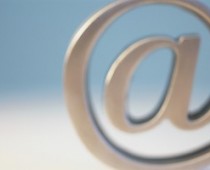Every now and again something you’ve hoped for happens and you simply have to shout it from the rooftops, knowing full well that it is WAY more exciting to you than it is to anyone else.
This is one of those moments. After all…we’re told to celebrate our accomplishments, right?
The following article was chosen in the 2010 Writer’s Digest writing competition within the “Magazine Feature Article” category. Not only will it be listed as such in an upcoming issue of Writer’s Digest Magazine, but it brings me one step closer to a couple of my writing goals.
I welcome you to a “virtual clink” as I raise a very deep glass filled with rich purple notes of plum, cherries & oak.
Salud!
 The Writes and Wrongs of Email Messaging
The Writes and Wrongs of Email Messaging
Communicating via email is as commonly used as the remote of a TV. In fact, this extraordinary tool has become quite the ordinary, in both personal and professional communications. Consequently, using effective, creative messaging methods while remembering your online e-manners can help increase business, strengthen relationships and introduce convenience practices into your professional habits.
Emails can, for instance;
- Create a paper trail (proof when it is needed)
- Serve as quick, convenient reminders (to both you and to your recipients)
- Be less time consumptive than leaving a voicemail or waiting for return calls
- Allow you time to consider your message and revise where necessary
- Allow you to eliminate emotion from potentially awkward interactions
- Enable conversations with multiple recipients with the effort of only one interaction
Nevertheless, the tendency to become too comfortable can lead to sloppiness. Learn to monitor your email practices and AVOID these writing wrongs;
- Using the TO: section for multiple addresses. This is the biggest business faux pas in email history. Never use the TO: section to send a mass email…that’s what they make the BCC: section for (which stands for Blind Carbon Copy). Not only does this practice indicate an impersonal correspondence and a lack of knowledge on how to use email, it also invades the privacy of every name on that list. Mass emails left open for all to see create the serious potential for contact piracy and the spreading of electronic viruses.
- Vague or non-existing Subject Lines. Differentiate yourself from spammers by “fessing” up to what you want to talk about.
- Failure to choose your words wisely. Emails do not have the liberty of communicating emotion, tonality or inflection. Your words are the only tool you have when writing; always double check for synonyms, generalizations or double meanings.
- Tendency to answer too quickly. Brevity and accuracy are important, but miscommunication is a risk when answering in a rush or from your smart phone. Take time to review before pressing the ‘send’ button.
- Being too relaxed with grammar, spelling and slang. If you want to use acronyms, abbreviations and phonetic contractions, send a text or an instant message. Email is still the preferred way of sending business messages and should be treated with professionalism.
- Sending lengthy or unorganized information. Keep correspondences to one per subject – that means limiting each email to its own message points, attachments or links. Send a second email with the content of another subject. In the age of professional attention deficit disorder, an email with more than one message may not be read in its entirety and the risk of miscommunication increases.
- Relying on the auto-spellchecker. Many misspellings actually do make accurate words…they just might not be the words you intended to write. Don’t assume that your spell-check knows you meant “know” rather than “no” or “dessert” rather than “desert”.
- Overlooking your contact information. Even when corresponding to familiar people, it is a point of convenience and courtesy to include a signature with contact information at the end of each message. In the event that someone wants to respond with an immediate phone call or view your website, you don’t want them to waste time looking up your information.
- Placing personal information on company networks. Any email should be sent with the knowledge that at any given point, millions of viewers may have access. Companies always have the right to enforce compliance policies regarding privacy. If it can’t be read by your boss or your mom, save it for a phone call or for happy hour.
- Failure to delete long trails of pointless and unformatted content. Emails lose their convenience when someone must scroll endlessly to get to the intended message. If forwarding an existing message or a series of replies, do everyone the favor of deleting the unnecessary text. Stick to the point.
- Hitting “Reply All”. Unless each recipient of an email must be privy to all responses, your reply should only be sent to the email originator. It is time consuming and careless to include each person in a correspondence intended only for the sender.
Now let’s work on that second celebratory glass.






